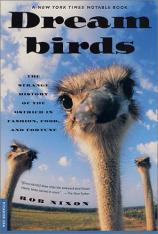Dreambirds: The Strange History of the Ostrich in Fashion, Food and Fortune
Review
Dreambirds: The Strange History of the Ostrich in Fashion, Food and Fortune
Rob Nixon's DREAMBIRDS at first seems fairly obscure --- on the cover a pair of ornery-looking, long-eyelashed birds stare us down, and a subtitle reads "The Strange History of the Ostrich in Fashion, Food, and Fortune." It is, indeed, a book about ostriches, in the vein of such recent micro-histories as Mark Kurlansky's COD: A Biography of the Fish That Changed the World (1998) or Larry Zuckerman's THE POTATO: How the Humble Spud Rescued the Western World (1999). But, like the best nonfiction, Nixon's book profiles small and rather bizarre corners of the world --- the ostrich ranchers of South Africa and their latter-day counterparts in the American Southwest --- while at the same time managing to cover a lot of ground, including family and social histories, politics and apartheid, ornithology and geography, and the dense and rich emotional landscape of childhood.
Nixon, a professor of literature and an experienced journalist, takes us back to his childhood in the Karoo, the South African desert that is home to thorny mimosa trees, flowers that disguise themselves as stones, and of course, ostriches --- curious birds identified by Carl von Linné, the taxonomist, as Struthio camelus, the "sparrow-camel." An Arab folk tale relates that when ostriches were asked to say whether they were birds or mammals, they could not choose and so were condemned by God to live in the Karoo, one of the most unforgiving deserts on earth.
Growing up there, Nixon felt as if he was living on the far ends of the earth. "Books were northern creatures that seemed to wing their way towards us from as far off as any migrating bird. I could never find the world around me in the words I read." This changes when his father gives him a copy of Albert Jackson's TRADER ON THE VELD. "I never knew that a book could be crammed with so many things, so many places that I knew."
With that, Nixon embarks on the fascinating story of Albert Jackson and men like him, Jews who fled the pogroms in 19th century Eastern Europe for the "Jerusalem of Africa," hoping to find their fortunes in gold, diamonds, or the ostrich trade. The Jews and other European immigrants to South Africa were timely; the late Victorian age witnessed the world's first ostrich boom, fueled by a craze for extravagance in which ostrich plumes supplied height, lift, and a touch of the exotic to dresses, capes, fans, and towering hats. For a few decades, ostrich plumes were worth more than gold, and the "ostrich elite" lived like kings in feather palaces that collapsed like so many castles in the sand with the advent of World War I and more somber fashions.
These ostrich ranchers are the book's first dreamers; we meet their counterparts at the American Ostrich Association meeting, where talk of low-calorie "ratite" steaks, fancy ostrich-hide cowboy boots, and $20,000 breeding pairs gives rise to ostrich-mania: "You can't teach an ostrich to fly," intones one ostrich promoter. "But you can succeed and find success for whatever heights you choose. The road is open, the ladder's up and the sky's the limit. Whatever you vividly imagine, ardently desire, sincerely believe and enthusiastically act upon must and will come to pass."
Rather than scoff at the folly of these would-be ostrich cowboys --- or poke fun at the gawky, flightless birds themselves --- Nixon weaves a fascinating tale out of the birds, characters, and places that he so clearly loves. In the desert landscape he unearths strangely fascinating tales --- an aging white woman and her young black assistant who build concrete statuary in the middle of the Karoo; an American couple who fled the city for a life of rattlesnake trapping in the desert; the wintering cranes who perform mating dances in an Arizona field. If anything, the book is loosely structured around the notion of the past as a dream that never quite goes away; in all, it's an effortlessly written, pleasingly anecdotal book --- perfect for birders and non-birders alike.
Reviewed by Martha Hostetter on March 1, 2001
Dreambirds: The Strange History of the Ostrich in Fashion, Food and Fortune
- Publication Date: March 1, 2001
- Genres: Nonfiction
- Paperback: 289 pages
- Publisher:
- ISBN-10: 0312270127
- ISBN-13: 9780312270124



